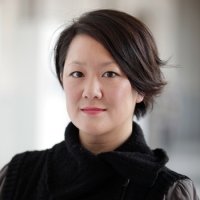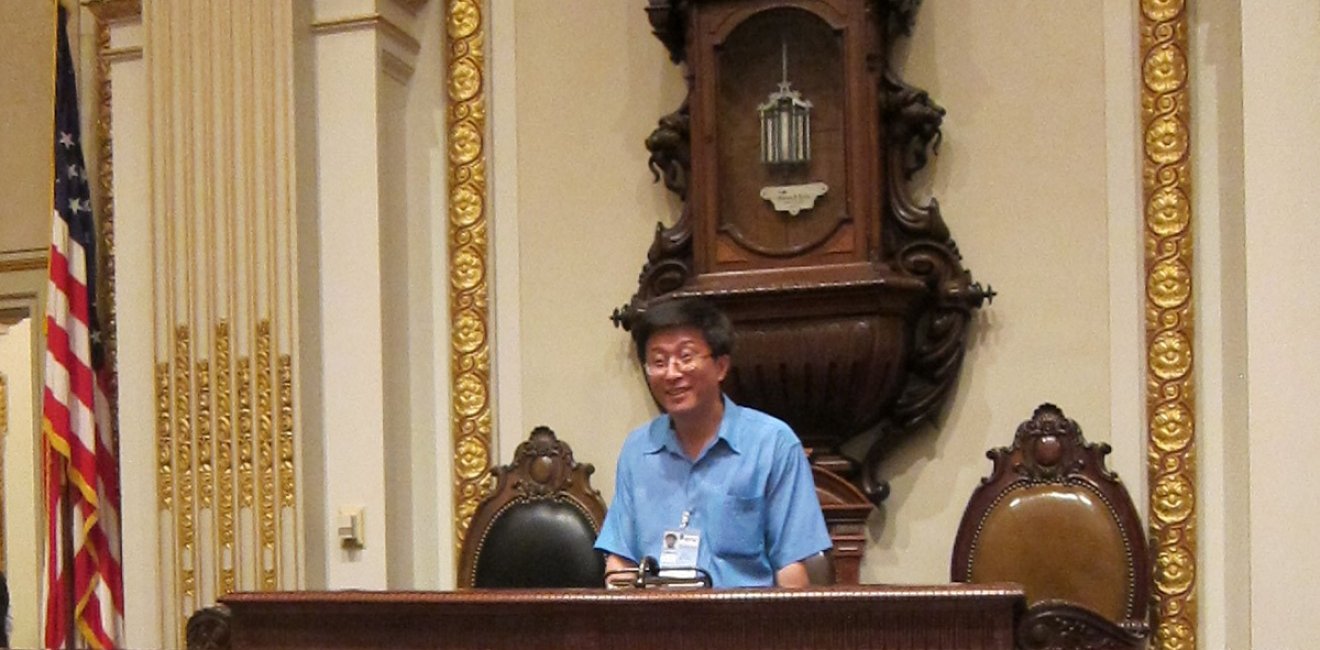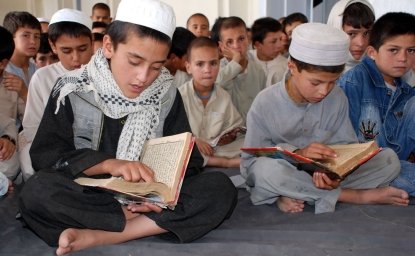
A blog of the Indo-Pacific Program
Image: North Korean diplomat Kim Hyok Chol at the New York Stock Exchange in June 2011 (Photo credit: Jean H. Lee)
Some years ago, I invited a group of North Koreans to meet me in New York to negotiate the opening of the first U.S. news bureau in Pyongyang. Among them was a mid-career diplomat being groomed to handle North American affairs. His name: Kim Hyok Chol.
Now a seasoned former ambassador to Spain, Kim is the man who has been sitting across the table from Special Representative Stephen Biegun, the former Ford executive tasked with leading the United States’ nuclear negotiations with North Korea.
Each has been entrusted by his leader with a formidable task in the runup to next week’s summit between President Donald Trump and North Korea’s Kim Jong Un: Biegun must nail Kim Hyok Chol down on what elements of its nuclear weapons program that North Korea is willing to relinquish in exchange for concessions from the United States. Kim, meanwhile, is under pressure to protect as much of Pyongyang’s nuclear assets as possible while wringing the most he can from Washington.
If these two men have done their jobs, the February 27-28 summit in Hanoi, Vietnam, the second in a year between Trump and Kim, has the promise of changing the course of U.S.-North Korean relations as well as regional security.
The central question is whether Kim Jong Un truly is ready to give up key elements of his treasured nuclear program in exchange for concessions from the United States that could profoundly transform the hermit country’s economy and its place in the world. And if so, whether Kim — whose seven years in power so far have been defined by defiance — can be trusted to follow through on his commitments.
Many, particularly in South Korea, insist Kim Jong Un has changed, believing that he has made a conclusive and permanent pivot away from provocation toward peace.
But I remain cautious. As someone who has watched him closely from the moment he emerged as heir apparent a decade ago, I do not see him as changing dramatically in thinking and outlook. Rather, the shift to diplomacy that we’ve watch unfold since early 2018 is part of a strategy meticulously mapped out to strengthen North Korea, with Kim at its helm. It was part of a plan that gained momentum with Trump’s election in 2016. His core missions have remained the same.
Reaching out to the United States to use nuclear assets as a bargaining chip with Washington was the strategy his father, Kim Jong Il, set out for him.
Reaching out to the United States to use nuclear assets as a bargaining chip with Washington was the strategy his father, Kim Jong Il, set out for him. I firmly believe Kim Jong Il hoped he would survive long enough to oversee this transition. But his death by heart attack in December 2011, just days after U.S. and North Korean negotiators hashed out the basic framework for a food-for-freeze deal later dubbed the “Leap Day Deal” because it was signed on February 29, 2012, required a change in strategy.
When I met Kim Hyok Chol in the summer of 2011, he was still operating under orders from Kim Jong Il, who before his death gave personal approval for the opening of a U.S. news bureau that he calculated would send a strong signal to the world about North Korea’s intention to repair relations with the Korean War foe.
I took Kim and his delegation all over Manhattan, including the New York Stock Exchange, as part of my bid to introduce them to capitalism and American commerce. My thought was to pitch to them that opening the AP bureau could serve as a first step toward broader engagement with the United States, including economic ties.
As dazzled and fascinated as they were, it turned out 2012 wasn’t the year for the transformational change in the U.S.-North Korea relationship that we had hoped for.
Newly ascended to leadership, Kim Jong Un — young, inexperienced and anxious to establish himself both at home and abroad — decided it wasn’t time to engage the United States. It was time, he decided, to build up the nuclear program to improve his position at the negotiating table.
In 2017, he used threatening rhetoric from President Trump to justify accelerating the pace of testing and proving that Pyongyang has the capability to build tiny hydrogen bombs for long-range ballistic missiles designed to strike the mainland United States. Satisfied that the tests did their job in strengthening his negotiating position, he turned his attention to diplomacy last year.
I would like to think that my experiment in taking the North Koreans to Wall Street and other sites across Manhattan — including an impromptu stop at Target, which might have been the North Koreans’ favorite visit — made an impression on Kim Hyok Chol, and that he is keeping these visions of economic prosperity in mind as he negotiates which elements of its nuclear program North Korea is willing to give up in return for U.S. concessions.
Kim Hyok Chol, conversant in English, congenial in nature, may seem to the Americans like a more viable interlocutor than Kim Yong Chol, the gruff, tough-talking envoy who led negotiations until handing off to the diplomat. (Kim Yong Chol did his part: getting the end-of-war declaration on the summit agenda.)
Kim Hyok Chol is a bureaucrat tasked with carrying out the orders handed down to him by a leader who has a well-laid plan for how North Korea will deal with the United States.
But I also know this is not about Kim Hyok Chol’s personality or personal opinions. Kim Hyok Chol is a bureaucrat tasked with carrying out the orders handed down to him by a leader who has a well-laid plan for how North Korea will deal with the United States. Kim Hyok Chol has neither the personal power nor the vision to act on his own, and that’s what makes him a formidable partner (or adversary) as he and Biegun sit down to negotiate the agenda for next week’s anticipated summit in Hanoi, Vietnam.
This negotiation, and the Trump-Kim summit, have the potential to transform the future of the Korean Peninsula. It could pave the way to an improved North Korean economy. But it could also put South Korea and Japan in greater peril if talks fail to guarantee improved regional security.
Just because I don’t buy the sudden change of heart doesn’t mean I don’t support engagement. Yes, Kim Jong Un has orchestrated this process. However, as someone who has worked in both Pyongyang and Seoul, I want to see intelligent, constructive and sustainable engagement that will lead to an improvement of the lives of the Korean people, in North Korea as well as in the South.
We must not forget that due to the Kim family’s policies, North Korea remains one of the world’s poorest, most isolated nations, with more than 40 percent of the population struggling to get food on the table every day and most suffering through this cold winter without heat, electricity, clean water, or medicine. Kim knows he cannot survive as leader unless he charts a different future for his country.
In the end, it is the United States that holds the power in this relationship. Kim wants and needs a better relationship with Washington to pave the way for inter-Korean engagement and a lifting of sanctions. But Biegun and his team must not be fooled: This turn toward diplomacy is not a sudden change of heart by a man who has seen the light. It is the latest step in a strategy designed to win Kim further credibility at home as well as improve his negotiating position abroad. U.S. negotiators must take into account what motivates Kim, how North Korea’s political structure governs the negotiating process and how to engage the North Koreans without putting the Korean people and peace in the region at greater risk if we want this summit to succeed.
Follow Jean H. Lee, director of the Hyundai Motor-Korea Foundation Center for Korean History and Public Policy, on Twitter and Instagram @newsjean. Follow the @Korea_Center on Twitter.
The views expressed are the author's alone, and do not represent the views of the U.S. Government or the Wilson Center. Copyright 2018, Asia Program. All rights reserved.
Related
Author

Journalist and former Pyongyang Bureau Chief, Associated Press

Indo-Pacific Program
The Indo-Pacific Program promotes policy debate and intellectual discussions on US interests in the Asia-Pacific as well as political, economic, security, and social issues relating to the world’s most populous and economically dynamic region. Read more


Hyundai Motor-Korea Foundation Center for Korean History and Public Policy
The Center for Korean History and Public Policy was established in 2015 with the generous support of the Hyundai Motor Company and the Korea Foundation to provide a coherent, long-term platform for improving historical understanding of Korea and informing the public policy debate on the Korean peninsula in the United States and beyond. Read more





